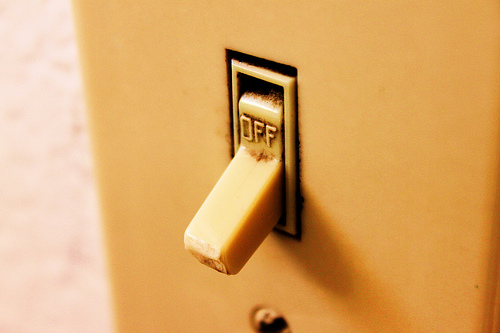
Photo by Steve St. Jude.
This week’s power blackouts in India were a reminder of the fragility of our complex infrastructure systems. As we noted on Tuesday, the chief problem was not enough power (in part because of coal-related production problems) paired with too much demand (in part because of high temperatures).
Here’s a roundup of some of the smarter analyses of how these problems came together to plunge India into darkness.
“Behind India’s Grid Breakdown, Deeper Energy Issues — and Opportunities” (Dot Earth):
The massive grid breakdown in India should not come as a surprise at all. The surprise part is why it did not happen before. It has been a ticking time bomb. Coal and nuclear will not solve the issue. Energy inefficiency, creaking infrastructure (increasing transmission and distribution losses), lowering of water tables and electricity theft all have to be taken care of at once. Increased urbanization is caused mostly by rural migrants. Proper planning of new urban houses is essential and also a great opportunity. For example, such housing could be designed for better day lighting (and easily could be designed in combination with renewables like solar from day one).
In Delhi, having modern buildings with glass facades that trap heat (increasing the need for heavy air conditioners) just does not make sense. Modern buildings have been designed with scant respect for the local environment and have been built for outward show.
In the name of satisfying voters, huge subsidies for electricity for agricultural water pumping have led to to rapid depletion of groundwater, thus leading to the need for more powerful water pumps, and thus the need for more electricity — a vicious cycle.
About that water.
“How Climate Change and the Monsoons Affect India’s Blackouts” (Time):
The great summer storms—which provide three-quarters of India’s annual rainfall—came late to the country this year, leaving much of northern India gripped in a killer drought and unrelenting heat. While the slow monsoons are unlikely to have directly caused the blackouts—the rains finally began to fall recently, enough to reduce temperatures—parched farmers in agricultural areas are turning to electric pumps in large numbers to bring groundwater to the surface for irrigation. If the monsoons continue to be erratic and slow in a global warming future, the demand for electricity to compensate for the heat and the drought will only increase.
The cause, high demand, may only be remedied through politics.
“Solar Power Helped Keep the Lights On in India” (Scientific American):
[S]ome of the formerly energy poor — rural villagers throughout the subcontinent — found themselves better off than their middle-class compatriots during the recent blackouts, thanks to village homes outfitted with photovoltaic panels. In fact, solar power helped keep some electric pumps supplying water for fields parched by an erratic monsoon this year.
The thirst for electricity stems from burgeoning demand from India’s middle class, which has embraced everything from air conditioning to the electric-powered subway trains of New Delhi. India also enjoys some of the highest rates of what is known in the trade as “non-technical losses,” i.e. people hijacking electric supplies and not paying for it (as opposed to “technical losses,” like the amount of electricity lost via the physics of transmission itself and the like.) And then there are the politically popular programs like providing free power to farmers for irrigation pumps.
Such politics no doubt played a role. Tensions between state governments, the national government and power suppliers are legion, including some areas that take more electricity than they are supposed to at times.
“The Slow-Motion Political Crisis Behind India’s Power Outage” (The Atlantic):
The biggest problem afflicting the power sector today is a lack of market-based pricing for fuel. With the Manmohan Singh government seen on its last legs and elections expected either in 2013 or early 2014, his coalition government is crippled by expanding populist demands by local politicians. An estimated 20,000 megawatts of generating capacity is idle because of a lack of gas and coal. There is no shortage. The government is unwilling to allow market-based prices for the fuel and the power generated so utility companies are unwilling
In many ways, the present power crisis is a metaphor for how local politics is eating away at the Singh government’s ability to make rational policies at the central level. For example, the present grid crisis is being partially blamed on the largest state, Uttar Pradesh, overdrawing electricity from the northern grid. But Uttar Pradesh is ruled by a regional party that Singh needs in order to pass legislation. So though the outgoing power minister (he was transferred to another post even before Tuesday’s crisis was fully resolved) promised penal action against UP, everyone knows that electoral politics will ensure that nothing more than a slap on the wrist will follow.
Boing Boing looked at what lessons we can learn about our infrastructure.
“Meet the people who keep your lights on” (Boing Boing):
If you want to understand why our grid is weak, you first need to understand how it works. The key thing to know is this — at any given moment, in any given place, we must have an almost perfect balance between electric supply and electric demand. Fluctuations of even fractions of a percent can send parts of the system towards blackout.
More importantly, that careful balance does not manage itself. Across North America there are people working, 24-7, to make sure that your lights can turn on, your refrigerator runs, and your computer works. They’re called grid controllers or system operators. Most utility customers have never heard of these guys, but we’re all heavily dependent on them. They keep the grid alive and, in turn, they keep our lives functioning–all without the benefit of batteries or any kind of storage.
The Onion provided its distinct combination of sharp humor with the sensation of pouring acid into your heart.
“300 Million Without Electricity In India After Restoration Of Power Grid” (The Onion):
According to estimates, roughly one-third of a billion Indian citizens were left without power Wednesday after workers successfully repaired the nation’s electrical grid and brought all of its systems back online. “Since restoring our infrastructure to 100 percent capacity following Monday and Tuesday’s blackouts, vast swaths of India are now completely without access to electricity,” said the country’s power minister, Veerappa Moily, who confirmed that three out of every four residents lacked access to such basic amenities as lighting, food refrigeration, and the use of simple appliances now that the country’s grid had fully recovered.
The real kicker is this.
NDTV interviewed Sushilkumar Shinde, India’s new home minister. He was promoted this week from his former position — as the guy in charge of the power system. Asked how he did in that role, he was frank. “Excellent.”
And here we thought there was a problem.



